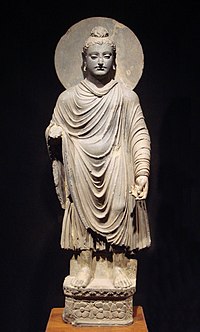"Sek-khia-mô͘-nî" pán-pún chi-kan bô-kāng--ê tē-hng
刪去的內容 新增的內容
無編輯摘要 |
|||
| Tē 1 chōa: | Tē 1 chōa: | ||
{{Infobox religious biography |
|||
| other_names = Shakyamuni ("Sage of the [[Shakya]]s") |
|||
| image = Buddha in Sarnath Museum (Dhammajak Mutra).jpg |
|||
| caption = [[Buddha Preaching his First Sermon (Sarnath)|Statue of Gautama Buddha]], preaching his first sermon at [[Sarnath]]. Gupta period, ca. 475 CE. [[Sarnath Museum|Archaeological Museum Sarnath]] (B(b) 181).{{refn|group="note"|name="Buddha-statue"}} |
|||
| module = {{Infobox Chinese|child=yes| headercolor= #FFCC33 |
|||
| san = Siddhārtha Gautama |
|||
| pli = Siddhattha Gotama }} |
|||
| birth_name = Siddhartha Gautama |
|||
| birth_date = {{circa|563 BCE or 480 BCE}} |
|||
| death_date = {{circa|483 BCE or 400 BCE}} (aged 80){{sfnp|Cousins|1996|pp=57–63}}{{sfnp|Norman|1997|p=33}}{{sfnp|Prebish|2008}} |
|||
| birth_place = <!---Note: Gautama was a Shakya, born in the Shakya republic. The states of both Nepal and India did not exist at that time. The Shakya territory covered an area which is nowadays partly in Nepal, partly in India.--->[[Lumbini]], [[Shakya|Shakya Republic]] (according to Buddhist tradition){{refn|group=note|name="birthplace"}}<!-- Do not change without getting consensus on talk page first --> |
|||
| death_place = [[Kushinagar]], [[Malla (tribe)|Malla Republic]] (according to Buddhist tradition){{refn|group="note"|name="deathplace"}} |
|||
| resting_place = [[Relics associated with Buddha|Cremated; ashes divided among followers]] |
|||
| known_for = Founding [[Buddhism]] |
|||
| predecessor = [[Kassapa Buddha]] |
|||
| successor = [[Maitreya]] |
|||
| father = [[Śuddhodana]] |
|||
| mother = [[Maya (mother of Buddha)|Maya Devi]] |
|||
| spouse = [[Yashodhara]] |
|||
| children = {{hlist|[[Rāhula]]|}} |
|||
}} |
|||
[[File:Gandhara Buddha (tnm).jpeg|200px|thumb|right|Sek-khia-mô͘-nî]] |
[[File:Gandhara Buddha (tnm).jpeg|200px|thumb|right|Sek-khia-mô͘-nî]] |
||
2022-nî 8-goe̍h 19-ji̍t (pài-gō·) 20:22 ê siu-tēng-pún

Sek-khia-mô͘-nî (Hàn-jī: 釋迦牟尼; Hôan-bûn:शाक्यमुनि, Śākyamuni), he̍k-chiá kiò Sek-khia-mô͘-nî-hu̍t, Sek-khia-hu̍t, gôan-miâ Siddhārtha Gautama (सिद्धार्थ गौतम), sī Hu̍t-kàu ê chhòng-sí-jîn. Sêng-hu̍t chi-āu pī chun-chheng hu̍t-tô, bîn-kan iā chhiâng-chāi chheng chò Hu̍t-chó͘, ì-sù sī thiat-ngō͘ í-tiū, jîn-seng chin-siòng chiá.
I chhut-sì kap koè-sin ê ji̍t-chí bô chin khak-tēng, tāi-iok sī chêng 563 nî kap chêng 483 nî, mā ū lâng jîn-ûi i sī 411 nî chó-iū koè-sin.
Tsù-sik
- ↑ Some sources mention Kapilavastu as the birthplace of the Buddha. Gethin states: "The earliest Buddhist sources state that the future Buddha was born Siddhārtha Gautama (Pali Siddhattha Gotama), the son of a local chieftain—a rājan—in Kapilavastu (Pali Kapilavatthu) what is now Nepal."Gethin 1998, p. 14 Gethin does not give references for this statement.
Ín-iōng chhò-gō͘: 在 <references> 中定義的 <ref> 標籤設定 name 屬性為 "birthplace",但在前文中並未使用。
Ín-iōng chhò-gō͘: 在 <references> 中定義的 <ref> 標籤設定 name 屬性為 "Buddha-statue",但在前文中並未使用。
<references> 中定義的 <ref> 標籤設定 name 屬性為 "deathplace",但在前文中並未使用。Tsù-kái
- ↑ "Lumbini, the Birthplace of the Lord Buddha". World Heritage Convention. UNESCO. 26 May 2011 khòaⁿ--ê.
- ↑ "The Astamahapratiharya: Buddhist pilgrimage sites". Victoria and Albert Museum. goân-loē-iông tī 31 October 2012 hőng khó͘-pih. 25 December 2012 khòaⁿ--ê.
Guā-pōo lên-ket
| Wikisource has original works written by or about: Sek-khia-mô͘-nî |
- [1] tī Project Gutenberg ê chok-phín
- Buddha tī Internet Archive ê chok-phín
- Siddhārtha Gautama tī Internet Archive ê chok-phín
- Shakyamuni tī Internet Archive ê chok-phín
- Works by Sek-khia-mô͘-nî at LibriVox (public domain audiobooks)

- Buddha on In Our Time at the BBC
- A sketch of the Buddha's Life
- What Was The Buddha Like? by Ven S. Dhammika
- Parables and Stories of Buddha Archived 9 March 2022 at the Wayback Machine.
- Who was the Buddha? Buddhism for Beginners

